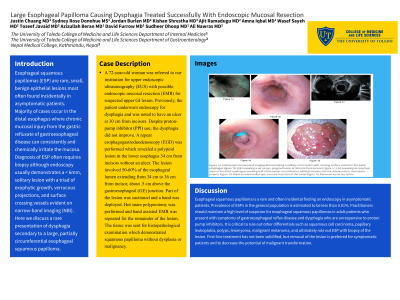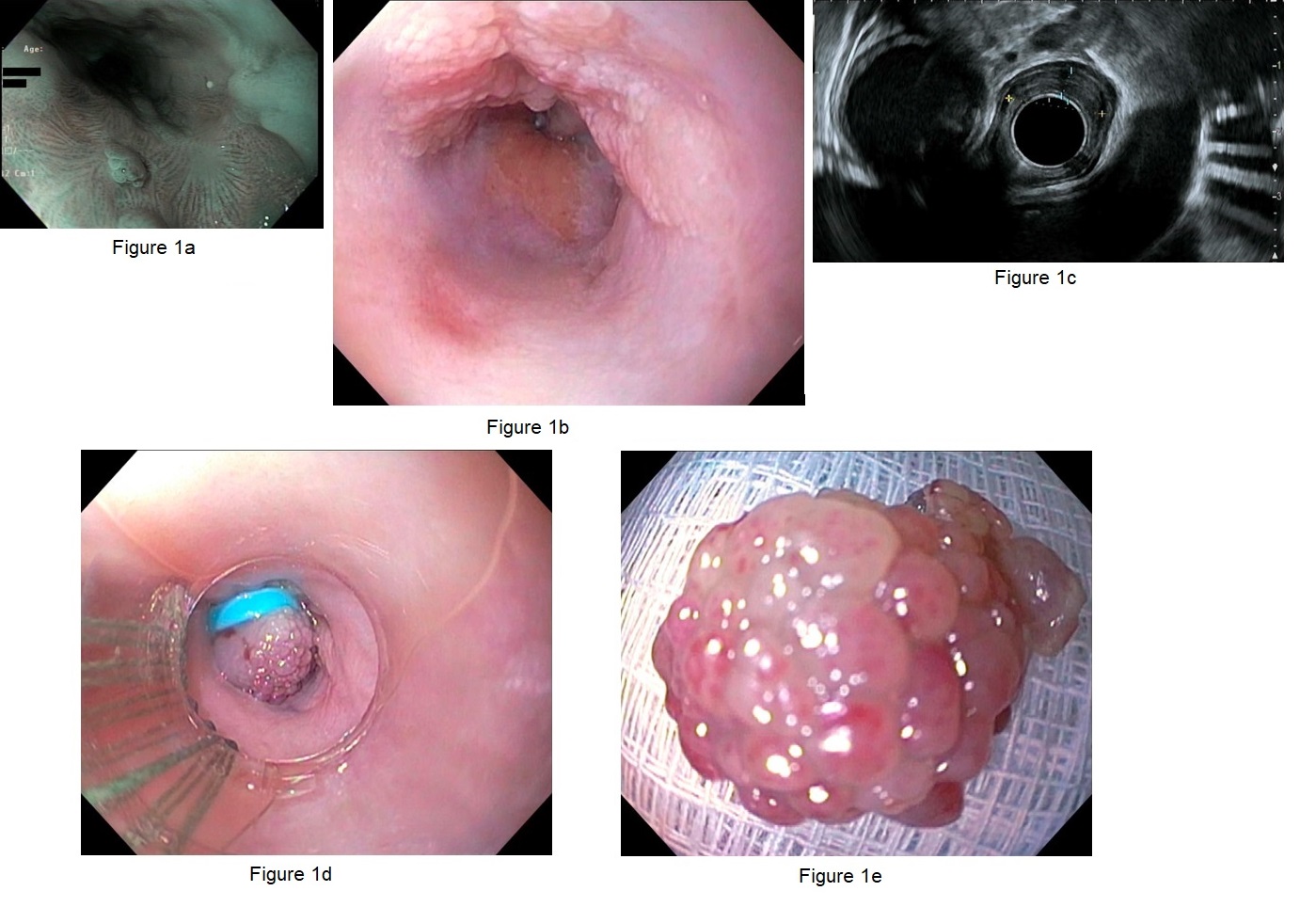Back


Poster Session E - Tuesday Afternoon
Category: Esophagus
E0213 - Large Esophageal Papilloma Causing Dysphagia Treated Successfully With Endoscopic Mucosal Resection
Tuesday, October 25, 2022
3:00 PM – 5:00 PM ET
Location: Crown Ballroom

Has Audio
- JC
Justin Chuang, MD
University of Toledo
Toledo, OH
Presenting Author(s)
Justin Chuang, MD1, Sydney Rose Donohue, MS1, Jordan Burlen, MD2, Kishan Shrestha, MD3, Ajit Ramadugu, MD1, Amna Iqbal, MD1, Wasef Sayeh, MD1, Toseed Javaid, MD1, Azizullah A. Beran, MD4, David Farrow, MD1, Sudheer Dhoop, MD1, Ali Nawras, MD1
1University of Toledo, Toledo, OH; 2The Ohio State University, Toledo, OH; 3Nepal Medical College Teaching Hospital, Kathmandu, Bagmati, Nepal; 4The University of Toledo, Toledo, OH
Introduction: Esophageal squamous papillomas (ESP) are rare, small, benign epithelial lesions most often found incidentally in asymptomatic patients. Majority of cases occur in the distal esophagus where chronic mucosal injury from the gastric refluxate of gastroesophageal disease can consistently and chemically irritate the mucosa. Diagnosis of ESP often requires biopsy although endoscopy usually demonstrates a < 6mm, solitary lesion with a triad of exophytic growth, verrucous projections, and surface crossing vessels evident on narrow-band imaging (NBI). Here we discuss a rare presentation of dysphagia secondary to a large, partially circumferential esophageal squamous papilloma.
Case Description/Methods: A 72-year-old woman was referred to our institution for upper endoscopic ultrasonography (EUS) with possible endoscopic mucosal resection (EMR) for suspected upper GI lesion. Previously, the patient underwent endoscopy for dysphagia and was noted to have an ulcer at 30 cm from incisors. Despite proton-pump inhibitor (PPI) use, the dysphagia did not improve. A repeat esophagogastroduodenoscopy (EGD) was performed which revealed a polypoid lesion in the lower esophagus 34 cm from incisors without an ulcer. The lesion involved 50-60% of the esophageal lumen extending from 34 cm to 36 cm from incisor, about .5 cm above the gastroesophageal (GE) junction. Part of the lesion was suctioned and a band was deployed. Hot snare polypectomy was performed and band assisted EMR was repeated for the remainder of the lesion. The tissue was sent for histopathological examination which demonstrated squamous papilloma without dysplasia or malignancy.
Discussion: Esophageal squamous papilloma is a rare and often incidental finding on endoscopy in asymptomatic patients. Prevalence of ESPs in the general population is estimated to be less than 0.01%. Practitioners should maintain a high level of suspicion for esophageal squamous papillomas in adult patients who present with symptoms of gastroesophageal reflux disease and dysphagia who are unresponsive to proton pump inhibitors. It is critical to rule out other differentials such as squamous cell carcinoma, papillary leukoplakia, polyps, leiomyoma, malignant melanoma, and ultimately rule out ESP with biopsy of the lesion. First-line treatment has not been solidified, but removal of the lesion is preferred for symptomatic patients and to decrease the potential of malignant transformation.

Disclosures:
Justin Chuang, MD1, Sydney Rose Donohue, MS1, Jordan Burlen, MD2, Kishan Shrestha, MD3, Ajit Ramadugu, MD1, Amna Iqbal, MD1, Wasef Sayeh, MD1, Toseed Javaid, MD1, Azizullah A. Beran, MD4, David Farrow, MD1, Sudheer Dhoop, MD1, Ali Nawras, MD1. E0213 - Large Esophageal Papilloma Causing Dysphagia Treated Successfully With Endoscopic Mucosal Resection, ACG 2022 Annual Scientific Meeting Abstracts. Charlotte, NC: American College of Gastroenterology.
1University of Toledo, Toledo, OH; 2The Ohio State University, Toledo, OH; 3Nepal Medical College Teaching Hospital, Kathmandu, Bagmati, Nepal; 4The University of Toledo, Toledo, OH
Introduction: Esophageal squamous papillomas (ESP) are rare, small, benign epithelial lesions most often found incidentally in asymptomatic patients. Majority of cases occur in the distal esophagus where chronic mucosal injury from the gastric refluxate of gastroesophageal disease can consistently and chemically irritate the mucosa. Diagnosis of ESP often requires biopsy although endoscopy usually demonstrates a < 6mm, solitary lesion with a triad of exophytic growth, verrucous projections, and surface crossing vessels evident on narrow-band imaging (NBI). Here we discuss a rare presentation of dysphagia secondary to a large, partially circumferential esophageal squamous papilloma.
Case Description/Methods: A 72-year-old woman was referred to our institution for upper endoscopic ultrasonography (EUS) with possible endoscopic mucosal resection (EMR) for suspected upper GI lesion. Previously, the patient underwent endoscopy for dysphagia and was noted to have an ulcer at 30 cm from incisors. Despite proton-pump inhibitor (PPI) use, the dysphagia did not improve. A repeat esophagogastroduodenoscopy (EGD) was performed which revealed a polypoid lesion in the lower esophagus 34 cm from incisors without an ulcer. The lesion involved 50-60% of the esophageal lumen extending from 34 cm to 36 cm from incisor, about .5 cm above the gastroesophageal (GE) junction. Part of the lesion was suctioned and a band was deployed. Hot snare polypectomy was performed and band assisted EMR was repeated for the remainder of the lesion. The tissue was sent for histopathological examination which demonstrated squamous papilloma without dysplasia or malignancy.
Discussion: Esophageal squamous papilloma is a rare and often incidental finding on endoscopy in asymptomatic patients. Prevalence of ESPs in the general population is estimated to be less than 0.01%. Practitioners should maintain a high level of suspicion for esophageal squamous papillomas in adult patients who present with symptoms of gastroesophageal reflux disease and dysphagia who are unresponsive to proton pump inhibitors. It is critical to rule out other differentials such as squamous cell carcinoma, papillary leukoplakia, polyps, leiomyoma, malignant melanoma, and ultimately rule out ESP with biopsy of the lesion. First-line treatment has not been solidified, but removal of the lesion is preferred for symptomatic patients and to decrease the potential of malignant transformation.

Figure: Figure 1a: Endoscopic narrow-band imaging demonstrating a solitary 2 mm lesion with crossing surface vessels in the distal esophagus
Figure 1b: EGD revealing a verrucous, polypoid lesion at 340 mm from incisors
Figure 1c: EUS revealing an isoechoic mass in the distal esophagus involving half of the lumen circumference without invasion into the submucosa or muscularis propria.
Figure 1d: Band assisted endoscopic mucosal resection of the lesion
Figure 1e: Removed verrucous lesion
Figure 1b: EGD revealing a verrucous, polypoid lesion at 340 mm from incisors
Figure 1c: EUS revealing an isoechoic mass in the distal esophagus involving half of the lumen circumference without invasion into the submucosa or muscularis propria.
Figure 1d: Band assisted endoscopic mucosal resection of the lesion
Figure 1e: Removed verrucous lesion
Disclosures:
Justin Chuang indicated no relevant financial relationships.
Sydney Rose Donohue indicated no relevant financial relationships.
Jordan Burlen indicated no relevant financial relationships.
Kishan Shrestha indicated no relevant financial relationships.
Ajit Ramadugu indicated no relevant financial relationships.
Amna Iqbal indicated no relevant financial relationships.
Wasef Sayeh indicated no relevant financial relationships.
Toseed Javaid indicated no relevant financial relationships.
Azizullah Beran indicated no relevant financial relationships.
David Farrow indicated no relevant financial relationships.
Sudheer Dhoop indicated no relevant financial relationships.
Ali Nawras indicated no relevant financial relationships.
Justin Chuang, MD1, Sydney Rose Donohue, MS1, Jordan Burlen, MD2, Kishan Shrestha, MD3, Ajit Ramadugu, MD1, Amna Iqbal, MD1, Wasef Sayeh, MD1, Toseed Javaid, MD1, Azizullah A. Beran, MD4, David Farrow, MD1, Sudheer Dhoop, MD1, Ali Nawras, MD1. E0213 - Large Esophageal Papilloma Causing Dysphagia Treated Successfully With Endoscopic Mucosal Resection, ACG 2022 Annual Scientific Meeting Abstracts. Charlotte, NC: American College of Gastroenterology.
